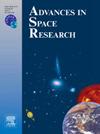在斯瓦尔巴群岛用介子和中子探测器对2024年5月太阳风暴期间Forbush减少的高纬度观测
IF 2.8
3区 地球科学
Q2 ASTRONOMY & ASTROPHYSICS
引用次数: 0
摘要
在2024年5月发生的一系列强烈的太阳耀斑和日冕物质抛射期间,地球上的宇宙射线通量出现了显著的福尔布什减少。虽然世界各地的粒子探测器都观测到了这一事件,但由于极地地区的地磁屏蔽较弱,斯瓦尔巴群岛受到了严重的影响。在这项研究中,利用斯瓦尔巴群岛上独特的介子和中子探测器组合对Forbush减少事件进行了分析:在Ny-Ålesund,极端能量事件(EEE)项目的三个基于闪烁体的介子望远镜,Bonner Sphere中子星光谱仪(BSS)的14个通道,以及用于水文监测的热中子和超热中子传感器;在巴伦支堡,由极地地球物理研究所操作的高能中子监测器。大多数传感器在事件中表现出显著的响应和相关性。观测到的Forbush衰减的相对幅度取决于探测器的能量灵敏度,热中子衰减≈9%,高能中子衰减≈8%,μ子衰减≈3%。这些结果的不确定性很大程度上取决于计数率等因素,计数率范围从101到105每小时,导致低信噪比,特别是对于BSS。这些多粒子和多能观测提供了地球在太阳活动期间暴露于宇宙射线的前所未有的观点。本文章由计算机程序翻译,如有差异,请以英文原文为准。
High latitude observation of the Forbush decrease during the May 2024 solar storms with muon and neutron detectors on Svalbard
During the series of intense solar flares and coronal mass ejections, that occurred in May 2024, a remarkable Forbush decrease in the cosmic ray flux was observed on the Earth. While this event was observed by particle detectors around the world, the archipelago of Svalbard was heavily exposed to it due to the weak geomagnetic shielding in the polar region. In this study, an analysis of the Forbush decrease event was carried out with a unique combination of muon and neutron detectors on Svalbard: at Ny-Ålesund three scintillator-based muon telescopes of the Extreme Energy Events (EEE) project, 14 channels of a Bonner Sphere neutron Spectrometer (BSS), and thermal and epithermal neutron sensors used for hydrological monitoring; and, at Barentsburg, a high-energy neutron monitor operated by the Polar Geophysical Institute. Most sensors showed significant responses and correlation during the event. The observed relative magnitude of the Forbush decrease was found to depend on the detector’s energy sensitivity and was for thermal neutrons, for high-energy neutrons, and for muons. The uncertainty of these results strongly depends on factors like the count rate, which ranged from to cph and resulted in a low signal-to-noise ratio particularly for the BSS. These multi-particle and multi-energy observations provide an unprecendented view on the Earth’s exposure to cosmic rays during solar events.
求助全文
通过发布文献求助,成功后即可免费获取论文全文。
去求助
来源期刊

Advances in Space Research
地学天文-地球科学综合
CiteScore
5.20
自引率
11.50%
发文量
800
审稿时长
5.8 months
期刊介绍:
The COSPAR publication Advances in Space Research (ASR) is an open journal covering all areas of space research including: space studies of the Earth''s surface, meteorology, climate, the Earth-Moon system, planets and small bodies of the solar system, upper atmospheres, ionospheres and magnetospheres of the Earth and planets including reference atmospheres, space plasmas in the solar system, astrophysics from space, materials sciences in space, fundamental physics in space, space debris, space weather, Earth observations of space phenomena, etc.
NB: Please note that manuscripts related to life sciences as related to space are no more accepted for submission to Advances in Space Research. Such manuscripts should now be submitted to the new COSPAR Journal Life Sciences in Space Research (LSSR).
All submissions are reviewed by two scientists in the field. COSPAR is an interdisciplinary scientific organization concerned with the progress of space research on an international scale. Operating under the rules of ICSU, COSPAR ignores political considerations and considers all questions solely from the scientific viewpoint.
 求助内容:
求助内容: 应助结果提醒方式:
应助结果提醒方式:


